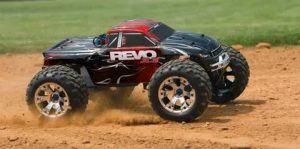
The speed of remote control (RC) cars can vary widely depending on several factors, including the type of RC car, its design, power source, and modifications. Here are some general guidelines:
- Toy-Grade RC Cars: Toy-grade RC cars, typically designed for children or beginners, have lower speeds compared to hobby-grade models. They usually range from 5 to 15 miles per hour (8 to 24 kilometers per hour). These cars are often powered by AA batteries or rechargeable battery packs.
- Hobby-Grade Electric RC Cars: Hobby-grade electric RC cars can achieve higher speeds due to more powerful electric motors and advanced technologies. On average, they can reach speeds between 20 and 50 miles per hour (32 to 80 kilometers per hour). Some high-end models and modified cars can exceed these speeds, going up to 70 miles per hour (112 kilometers per hour) or more.
- Hobby-Grade Nitro/Gas-Powered RC Cars: Nitro or gas-powered RC cars are known for their exceptional speed and acceleration. These cars use miniature internal combustion engines fueled by a nitro-methane mixture or gasoline. Depending on the model, they can reach speeds ranging from 30 to 70 miles per hour (48 to 112 kilometers per hour) or even higher. Some professional-grade nitro RC cars can exceed 100 miles per hour (160 kilometers per hour) with modifications.
It’s important to note that the top speed of an RC car can be influenced by factors such as the terrain, weather conditions, weight, aerodynamics, and the skill of the driver. Additionally, modifications and upgrades to the motor, batteries, tires, and other components can significantly enhance the speed capabilities of an RC car.
Toy-Grade RC Cars:
Toy-grade RC cars refer to remote-controlled cars that are designed and built primarily for recreational use and are generally targeted towards children or casual hobbyists. Here are some key points about toy-grade RC cars:
- Design and Construction: Toy-grade RC cars are typically made using lightweight materials such as plastic to keep costs down and make them more suitable for young users. They may not have the same level of durability as hobby-grade RC cars, but they are generally designed to withstand normal play and occasional crashes.
- Limited Performance: Toy-grade RC cars usually have limited performance capabilities compared to hobby-grade models. They may have slower speeds, less precise controls, and limited suspension and handling capabilities. These cars are primarily meant for fun and entertainment rather than competitive racing or advanced maneuvers.
- Easy to Use: Toy-grade RC cars are designed to be user-friendly and easy to operate, making them suitable for young children or beginners. They often feature simple controls with basic functions like forward, backward, left, and right. Some models may also include additional features such as sound effects or lights to enhance the play experience.
- Battery-Powered: Most toy-grade RC cars are powered by batteries, typically rechargeable ones. The battery life and charging time can vary depending on the model and usage. It’s important to note that toy-grade RC cars may have shorter run times compared to hobby-grade models due to the limitations of the battery capacity.
- Limited Customization and Upgrades: Toy-grade RC cars usually have limited options for customization and upgrades. Unlike hobby-grade RC cars that offer a wide range of aftermarket parts and accessories, toy-grade models are typically designed to be used as-is without extensive modifications.
- Affordability: One of the key advantages of toy-grade RC cars is their affordability. They are generally more budget-friendly compared to hobby-grade models, making them accessible to a wider audience. This affordability makes toy-grade RC cars a popular choice for children or casual RC enthusiasts who want to enjoy the thrill of remote-controlled vehicles without making a significant investment.
While toy-grade RC cars may not offer the same level of performance, durability, or customization options as hobby-grade models, they still provide a fun and enjoyable experience for young users or those looking for casual remote-controlled play.

Hobby-Grade Electric RC Cars:
Hobby-grade electric RC cars are a popular category of RC cars that are powered by electric motors. Here are some key points about hobby-grade electric RC cars:
- Electric Motors: Hobby-grade electric RC cars are equipped with electric motors that are powered by rechargeable batteries. These motors offer varying levels of power and speed, depending on the model and specifications. Electric motors are known for their quiet operation, ease of use, and low maintenance compared to nitro or gas-powered engines.
- Performance and Speed: Hobby-grade electric RC cars provide impressive performance and speed capabilities. They can accelerate quickly, reach high speeds, and offer responsive controls. The performance level can vary depending on the specific model, motor type, and battery configuration. High-performance electric RC cars are capable of achieving speeds comparable to or even exceeding those of nitro or gas-powered models.
- Battery and Runtime: Electric RC cars rely on rechargeable batteries for power. The battery capacity and type can influence the runtime of the car. LiPo (Lithium Polymer) batteries are commonly used in hobby-grade electric RC cars due to their high energy density and lightweight properties. The runtime of an electric RC car can range from a few minutes to over an hour, depending on factors such as battery capacity, driving style, and vehicle setup.
- Ease of Use and Maintenance: Electric RC cars are generally more user-friendly compared to nitro or gas-powered models. They require less maintenance since there is no need to deal with fuel mixture, tuning carburetors, or cleaning exhaust systems. Electric RC cars also eliminate the need for frequent engine break-in or tuning adjustments. Cleaning and lubricating moving parts, checking battery condition, and occasional motor maintenance are typically the main maintenance tasks.
- Availability of Models and Parts: Hobby-grade electric RC cars come in a wide range https://takizo.shop of models, styles, and scales to suit various preferences and purposes. There is a vast selection of ready-to-run (RTR) models available, which come fully assembled and include all the necessary components to start driving right away. Additionally, there is a wide availability of aftermarket parts and accessories, allowing enthusiasts to customize and upgrade their electric RC cars to suit their preferences and enhance performance.
- Indoor and Outdoor Use: Electric RC cars are well-suited for both indoor and outdoor use. They can be driven on smooth surfaces indoors, such as indoor tracks or large open spaces. Outdoors, they can handle various terrains, including pavement, gravel, dirt, and grass, depending on the design and capabilities of the specific model. However, it’s important to note that not all electric RC cars are waterproof, so caution should be taken when driving them in wet conditions.
Hobby-grade electric RC cars offer a balance of performance, ease of use, and maintenance compared to other types of RC cars. They are a popular choice among RC enthusiasts due to their impressive speed, responsiveness, and the convenience of electric power. Whether for racing, bashing, or casual driving, hobby-grade electric RC cars provide an enjoyable and accessible experience for hobbyists of all skill levels.
Hobby-Grade Nitro/Gas-Powered RC Cars:
Hobby-grade nitro or gas-powered RC cars are a step up from toy-grade models and are designed for more serious enthusiasts who want a higher level of performance and realism. Here are some key points about hobby-grade nitro or gas-powered RC cars:
- Nitro or Gas-Powered Engines: Hobby-grade RC cars in this category are typically powered by nitro fuel or gasoline engines, which provide increased power and speed compared to electric-powered models. Nitro engines use a special fuel mixture containing methanol, nitromethane, and oil, while gas-powered engines use gasoline.
- Performance and Speed: Nitro or gas-powered RC cars offer impressive speed and acceleration, making them suitable for racing or high-performance applications. These cars can reach higher speeds than electric-powered models and often provide a more thrilling and realistic driving experience.
- Realistic Engine Sound and Smoke: Nitro or gas-powered RC cars replicate the sound and exhaust emissions of real cars, adding to their authenticity and appeal. The engine produces a distinct sound and may emit exhaust smoke, further enhancing the realism and immersion during operation.
- Tuning and Maintenance: Nitro or gas-powered RC cars require more involved maintenance and tuning compared to electric models. This includes fuel mixture adjustments, tuning the carburetor, cleaning the air filter, and regular maintenance of the engine and drivetrain components. It’s important to have some mechanical knowledge and skills to properly maintain and tune these cars.
- Higher Cost: Hobby-grade nitro or gas-powered RC cars tend to be more expensive than electric-powered models. The cost is primarily due to the complexity and performance of the nitro or gas engine, as well as the higher quality materials used in construction. Additionally, the ongoing cost of fuel and maintenance should be considered.
- Longer Run Times: Nitro or gas-powered RC cars typically have longer run times compared to electric models, as they rely on an onboard fuel source rather than batteries. However, refueling and maintaining the engine during longer sessions may be necessary.
- Racing and Competitive Use: Nitro or gas-powered RC cars are popular choices for racing and competitive events. Their speed, power, and realistic engine sound make them well-suited for competitive racing circuits or off-road racing tracks. Many enthusiasts enjoy the thrill of competing against others and participating in organized races and events.
Hobby-grade nitro or gas-powered RC cars provide an exhilarating and realistic experience for RC enthusiasts who are passionate about high-performance vehicles. While they require more maintenance and expertise to operate compared to electric models, the speed, sound, and overall performance make them a popular choice for experienced hobbyists and competitive racers.